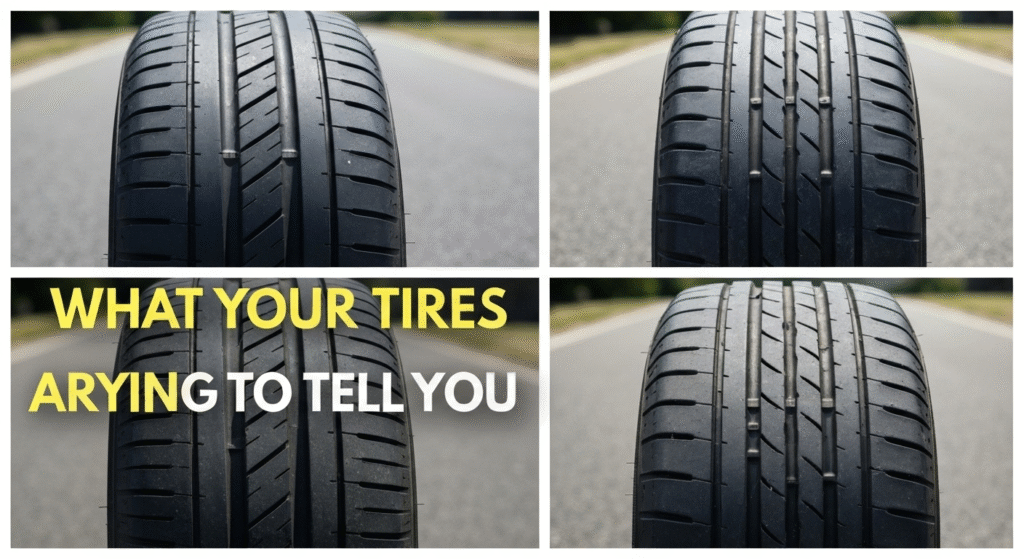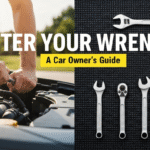Your car’s tires are its only connection to the road. They do more than just roll; they tell a detailed story about your vehicle’s health and alignment. Learning to read these stories can save you money, prevent a breakdown, and even keep you safer on the road. It’s one of the most important visual checks you can perform on your vehicle.
My name is Sharmin, and for the past five years, I’ve worked hands-on with hundreds of vehicles, diagnosing issues from the simple to the complex. One of the very first things I examine on any car is the tire wear. Long before I connect a diagnostic scanner, the patterns worn into the rubber provide clear clues about potential problems with alignment, suspension, or even just simple maintenance oversights. A quick look can tell me if a car is being cared for or if trouble is brewing underneath.
This guide will walk you through everything you need to know about checking your tires. We will break down the most common wear patterns, explain what they mean in simple terms, and outline the steps to fix the underlying problems. By the end, you will be able to look at your tires and understand exactly what your car is trying to tell you.
Getting Started: How to Properly Inspect Your Tires
Before you can decode the wear patterns, you need to know how to perform a safe and accurate inspection. A hasty check can lead you to miss important details. It’s a simple process, but doing it right is the key to getting good information from your tires.
First, always check your tires when they are “cold.” This means the car should have been parked for at least three hours or driven less than a mile. Driving heats the air inside the tires, causing it to expand and giving you an inaccurate pressure reading. I once saw a client get a perfect pressure reading at a gas station after a long highway drive, only for the “low pressure” light to come on the next morning when the tires were cold again.
Essential Steps for Inspection:
- Park on a Level Surface: This ensures the car’s weight is distributed evenly across all four tires, giving you a true picture of their contact with the ground. A sloped driveway can alter how the tires sit, potentially hiding an alignment issue.
- Turn the Steering Wheel: To see the full width of the front tires, turn your steering wheel hard to one side. This exposes the inner and outer edges, which are often the first places to show signs of alignment problems. Check one tire, then turn the wheel the other way to check the other.
- Use Your Hands and Eyes: Run your hand carefully across the tread of the tire. Your sense of touch can often detect subtle wear patterns like feathering or cupping before they become easily visible. Look for any cracks in the sidewall, bulges, or objects embedded in the rubber.
- Check Tread Depth: While the “penny test” is a classic trick, a dedicated tread depth gauge is more accurate and inexpensive. The U.S. legal minimum tread depth is 2/32 of an inch. A healthy tire should have significantly more. Consistent tread depth across the tire is just as important as the depth itself.
Pattern 1: Wear in the Center
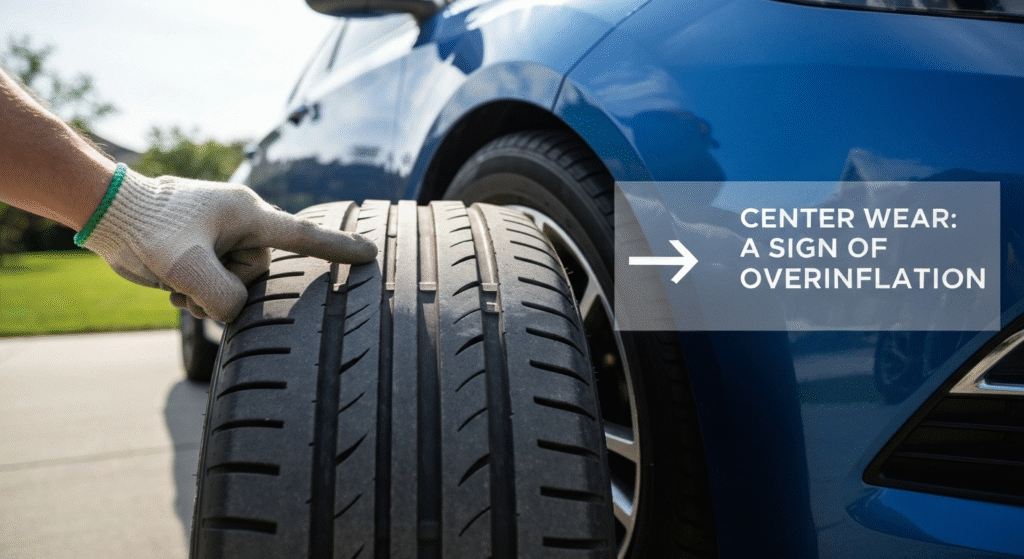
Let’s start with one of the most straightforward patterns. If you notice that the very center of your tire’s tread is wearing down much faster than the outer edges, you are looking at classic center wear. The tire might look like it’s bulging slightly in the middle, and this is where the most significant wear is concentrated.
What Causes Center Wear?
This pattern is almost always caused by one thing: overinflation. When a tire has too much air in it, the center of the tread bows out. Think of it like an overfilled balloon. This outward bulge lifts the outer edges of the tire off the pavement. As a result, only the center strip of the tread makes consistent contact with the road, causing it to wear down prematurely while the edges remain relatively untouched.
Many people overinflate their tires thinking it improves fuel economy, but the minor gain is not worth the cost of replacing tires early and the loss of safety.
Risks and Solutions
An overinflated tire is a risky tire. With less rubber touching the road, your car has reduced traction. This is especially dangerous in wet or slippery conditions, leading to longer stopping distances and an increased risk of skidding. The ride also becomes harsher, as the over-pressurized tire can’t absorb bumps as effectively.
The good news is that this is the easiest tire wear problem to fix.
| Center Wear Overview | |
| Visual Cue | The middle tread is worn down; outer edges have plenty of tread. |
| Primary Cause | Tire pressure is too high (overinflation). |
| Associated Risks | Reduced traction, longer braking distance, harsh ride, increased blowout risk. |
| Solution | Check and adjust tire pressure to the manufacturer’s recommended level. |
The Fix:
- Locate the correct tire pressure for your vehicle. This is not the number on the tire’s sidewall; that’s the maximum pressure. The correct pressure is on a sticker inside the driver’s side door jamb or in your owner’s manual.
- Use a reliable pressure gauge to check the pressure in all four tires.
- If the pressure is too high, press the small pin in the center of the valve stem to release air in short bursts until you reach the recommended Pounds per Square Inch (PSI).
Pattern 2: Wear on Both Outer Edges
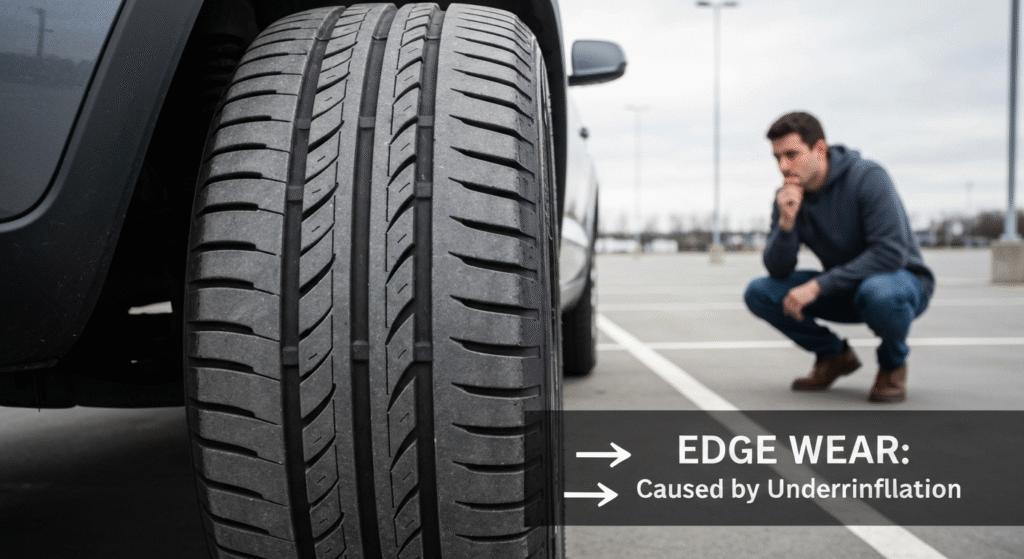
The opposite of center wear is edge wear, where both the inside and outside shoulders of the tire tread are worn down, but the center tread remains deep. When you run your hand across the tire, you’ll feel the significant drop-off from the center to the worn-down edges. This is a very common pattern, especially on cars that don’t have their tire pressure checked regularly.
What Causes Edge Wear?
This pattern is a clear sign of underinflation. When a tire doesn’t have enough air, its sidewalls can’t properly support the vehicle’s weight. The center of the tread flexes upward, lifting it off the road surface. This forces the outer edges of the tire to handle all the work of accelerating, braking, and turning. All that extra stress and friction on the shoulders causes them to wear out rapidly.
A few years ago, a student brought their first car to the shop complaining of “sloppy” steering. The car felt like it was wandering on the road. A quick check revealed all four tires were about 10 PSI below the recommended level, and the outer edges were heavily worn. Correcting the pressure made an immediate difference in the car’s handling.
Risks and Solutions
Underinflated tires are dangerous. The excessive flexing builds up a tremendous amount of heat, which is the number one enemy of a tire’s structure. This can lead to a sudden and catastrophic blowout, especially at highway speeds. Underinflation also hurts your fuel economy because the engine has to work harder to turn the “soggy” tires.
| Edge Wear Overview | |
| Visual Cue | Both outer edges are worn down; the center has plenty of tread. |
| Primary Cause | Tire pressure is too low (underinflation). |
| Associated Risks | Poor fuel economy, sluggish handling, high risk of heat-related blowouts. |
| Solution | Check and adjust tire pressure to the manufacturer’s recommended level. |
The Fix:
- Just like with overinflation, find the recommended PSI on the sticker in your door jamb.
- Use a pressure gauge to check all four tires.
- Use an air compressor at a gas station or a portable one to add air until you reach the correct PSI. It’s best to check this at least once a month.
Pattern 3: One-Sided Wear (Inner or Outer Edge Only)
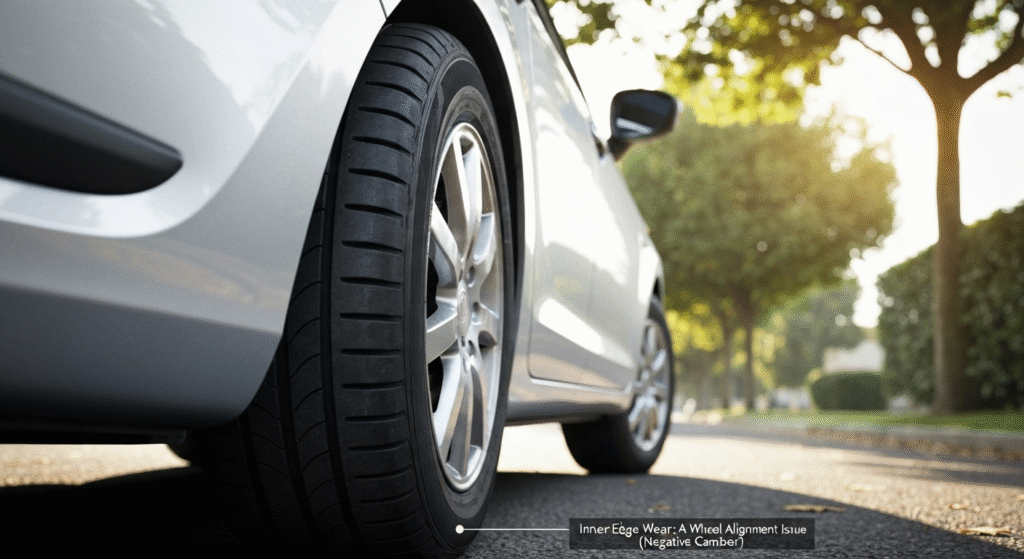
Now we move into issues that go beyond simple tire pressure. If you notice that only one edge of your tire—either the inner or outer shoulder—is wearing down, this is a strong indicator of a wheel alignment problem. Unlike the previous two patterns, this wear is asymmetrical.
Inner vs. Outer Edge Wear
- Inner Edge Wear: This means the tread on the side of the tire closest to the vehicle’s center is worn away.
- Outer Edge Wear: This means the tread on the outermost side of the tire is disappearing.
What Causes One-Sided Wear?
This type of wear is typically caused by improper camber alignment. Camber is the vertical tilt of your wheels when viewed from the front of the car.
- Negative Camber: If the top of the tire tilts inward toward the car, it has negative camber. This puts more pressure on the inner edge, causing it to wear out.
- Positive Camber: If the top of the tire tilts outward away from the car, it has positive camber. This places more stress on the outer edge, leading to wear.
Hitting a pothole, bumping a curb, or even normal wear and tear on suspension components like ball joints and bearings can knock your alignment out of specification.
Risks and Solutions
Misaligned wheels can cause your car to pull to one side, forcing you to constantly correct the steering. More importantly, it dramatically reduces the life of your tires. An alignment issue can ruin a brand-new set of tires in just a few thousand miles. It also puts unnecessary stress on your steering and suspension components.
| One-Sided Wear Overview | |
| Visual Cue | Only the inner edge OR the outer edge is worn down. |
| Primary Cause | Poor wheel alignment, specifically incorrect camber. Worn suspension parts can also be a factor. |
| Associated Risks | Vehicle pulling to one side, premature tire failure, increased stress on steering parts. |
| Solution | A professional wheel alignment service is required. |
The Fix:
This is not a do-it-yourself job. Your vehicle needs to be taken to a qualified mechanic or tire shop for a professional wheel alignment. They use specialized laser-guided equipment to measure and adjust your car’s suspension angles (camber, toe, and caster) back to the manufacturer’s precise settings.
Pattern 4: Cupping or Scalloping
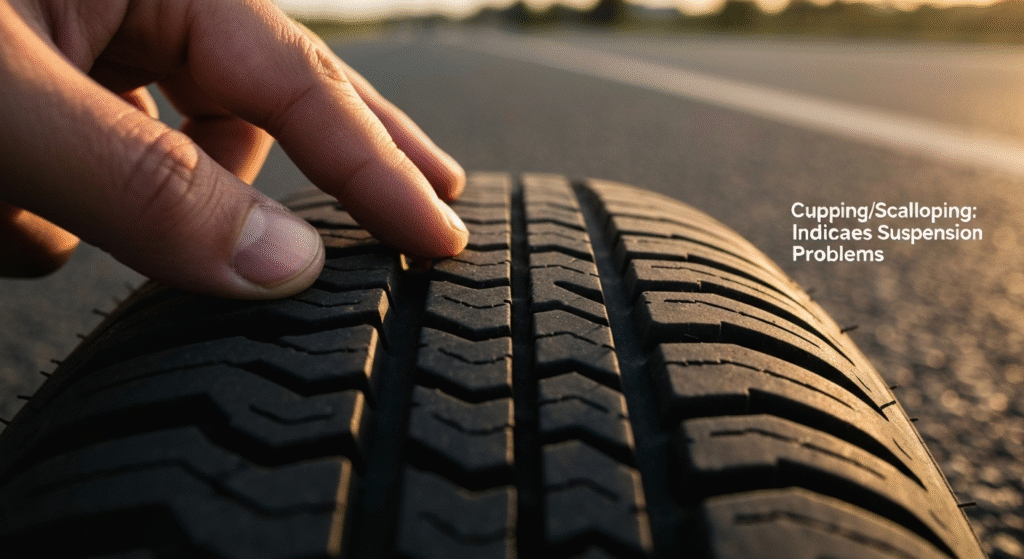
Cupping, also known as scalloping, appears as a series of diagonal scoops or dips worn into the tire’s tread. If you run your hand over the tire, it will feel like a series of hills and valleys instead of a smooth surface. This pattern often comes with a telltale noise—a rhythmic whirring or thumping sound that gets louder as you drive faster.
What Causes Cupping?
Cupping is a sign that the tire is bouncing up and down as it rolls down the road instead of spinning smoothly. This uncontrolled bouncing is almost always a symptom of worn-out or failing suspension components. The shocks or struts are responsible for dampening these bounces and keeping the tire planted firmly on the road. When they fail, the tire essentially slams into the pavement with every rotation, scooping out bits of rubber over time.
An out-of-balance tire can also contribute to or cause cupping, as the imbalance creates a vibration that can lead to a similar bouncing effect.
Risks and Solutions
The biggest risk here is a loss of vehicle control. A bouncing tire is not in constant contact with the road, which severely compromises handling and braking, especially on bumpy surfaces or during an emergency maneuver. The vibrations can also cause premature wear on other parts of your car, such as wheel bearings and ball joints.
| Cupping/Scalloping Overview | |
| Visual Cue | Diagonal scoops or dips around the tread surface; feels like hills and valleys. |
| Primary Cause | Worn-out shocks, struts, or other suspension parts. An imbalanced tire can also be a cause. |
| Associated Risks | Poor vehicle control, compromised braking, vibrations, damage to other components. |
| Solution | Have suspension checked by a mechanic. A wheel balancing and tire rotation may also be needed. |
The Fix:
- Take your vehicle to a reputable mechanic for a thorough suspension inspection. They can determine if your shocks, struts, or other parts need replacement.
- After fixing the suspension, it is wise to have your wheels balanced and rotated to ensure the remaining tires wear evenly. Unfortunately, a cupped tire will likely continue to make noise even after the problem is fixed, so replacement may be the only way to restore a quiet ride.
Pattern 5: Feathering
Feathering is a more subtle wear pattern that you can often feel better than you can see. It occurs when the tread ribs on one side are worn smooth while the other side remains sharp. If you run your hand across the tread in one direction, it will feel smooth. When you run it back the other way, it will feel sharp, like the edge of a saw blade.
What Causes Feathering?
Feathering is a classic sign of incorrect toe alignment. Toe refers to the direction your tires are pointing when viewed from above, like looking down at your feet.
- Toe-in: The front of the tires point slightly toward each other.
- Toe-out: The front of the tires point slightly away from each other.
When the toe is off, the tire is essentially being dragged sideways as it rolls forward. This constant scrubbing action wears one side of the tread blocks faster than the other, creating the feathered edge.
Risks and Solutions
The primary consequence of a toe issue is rapid tire wear. It also affects steering response and can make the vehicle feel less stable. Because the tire is constantly fighting against the direction it’s being steered, it can also lead to a slight decrease in fuel efficiency. This type of wear can be deceptive because the tire might still look like it has plenty of tread depth from a glance.
| Feathering Overview | |
| Visual Cue | Tread blocks are worn into a sawtooth or feathered pattern. |
| Primary Cause | Poor wheel alignment, specifically incorrect toe settings. |
| Associated Risks | Very rapid tire wear, imprecise steering, reduced fuel efficiency. |
| Solution | A professional wheel alignment service is required to correct the toe angle. |
The Fix:
Like camber issues, incorrect toe must be corrected with a professional wheel alignment. This is a precise adjustment that ensures your wheels are pointing straight ahead, allowing them to roll smoothly without scrubbing and causing premature wear.
Frequently Asked Questions (FAQ)
How often should I check my tire pressure?
You should check your tire pressure at least once a month and before any long road trips. Temperature changes affect tire pressure—you lose about 1 PSI for every 10°F drop in temperature—so it’s important to check more often during seasons with fluctuating weather.
Can I fix uneven tire wear myself?
If the wear is due to incorrect tire pressure (center or dual-edge wear), you can easily fix it yourself by adjusting the pressure. However, if the wear is caused by alignment or suspension issues (one-sided wear, cupping, feathering), you must take your vehicle to a professional mechanic for diagnosis and repair.
Does rotating my tires help prevent uneven wear?
Yes, absolutely. Regular tire rotation (typically every 5,000 to 7,500 miles) is one of the best things you can do for your tires. It helps even out the wear across all four tires, as front and rear tires wear at different rates. This extends their life and maintains balanced handling. For more information, the National Highway Traffic Safety Administration (NHTSA) provides excellent resources on tire safety and maintenance.
Once a tire has an uneven wear pattern, can it be reversed?
No, once the rubber is worn away, it’s gone for good. Fixing the underlying problem (like getting an alignment) will stop the pattern from getting worse, but it will not reverse the existing damage. This is why regular checks are so important—catching a problem early saves the tire.
Conclusion: Your Tires Are a Window to Your Car’s Health
Your tires are more than just black rubber circles; they are a vital diagnostic tool. By taking just a few minutes each month to inspect them, you can catch problems with alignment, suspension, and inflation long before they become expensive or dangerous. Understanding what the different wear patterns mean empowers you to take proactive care of your vehicle.
Remember the key takeaways: symmetrical wear in the center or on both edges points to tire pressure, while asymmetrical wear like one-sided patterns, cupping, or feathering points to mechanical issues like alignment or worn suspension. By listening to what your tires are telling you, you ensure a safer ride, extend the life of your tires, and keep your vehicle running smoothly for years to come.

